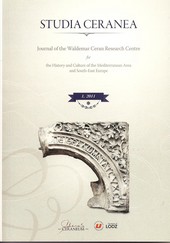John Chrysostom’s Tale on How Michael Vanquished Satanael – a Bogomil text?
John Chrysostom’s Tale on How Michael Vanquished Satanael – a Bogomil text?
Author(s): Georgi Minczew Subject(s): Language studies
Published by: Wydawnictwo Uniwersytetu Łódzkiego
Summary/Abstract: The study is an attempt at a comparative analysis of two pseudo-canonical texts: the Slavic Homily of John Chrysostom on How Michael Vanquished Satanael (in two versions) and the Greek Λόγος τοῠ ἀρχηστρατήγου Μιχαήλ, ὃταν ἐπῆρεν τήν στολήν (BHG 1288n). Both texts, very close to each other in terms of the plot, relate an ancient angelomachia between a heavenly emissary and a demiurge expelled from the angelic hierarchy. When examined against the background of dualistic heterodox doctrines on the one hand, and compared to other medieval cultural texts (be they liturgical, iconographical or folkloric) on the other, these works enable insight into how heterodox and pseudo-canonical texts functioned and were disseminated in the medieval Byzantine-Slavic cultural sphere. The Slavic Homily is not genetically related to its Greek counterpart, which is only preserved in a lat, 16th century copy. Rather, it was composed before the 13th century on the basis of another, non-extant model with a content similar to the pseudo-canonical Greek Homily. It is probable to a certain degree that the emergence of the Slavic work is connected with the growing interest in the cult of Archangel Michael in the First Bulgarian Empire, especially in the Diocese of Ohrid. Certain Gnostic ideas related to dualistic cosmology, as well as cosmogony, angelology and anthropology spread from the Judeo-Christian world to Byzantine literature and culture. Having undergone a number of transformations in the neo-Manichean communities of the Byzantine Empire and Bulgaria, they formed the basis for medieval dualistic cosmogony, as well as angelology and anthropology. Circulated both orally and in written form, beliefs concerning the invisible God, Archangel Michael as a ‘second God’ and the soul’s journey to Paradise became so widespread that they are not only found in heretic texts, but also cited almost verbatim in anti-heretic treatises. The content and later textual modifications of the Slavic Homily cast a doubt on the hypothesis concerning its Bogomil origin. Furthermore, it cannot be determined to what extent works such as the Homily were made use of by (moderate?) Bogomil communities. Even before the 14th century, the text underwent the processes of liturgization and folklorization, as proven by the presence of liturgical quotations (absent from the Greek text), the visualization of the story in sacred space as well as the aetiological legends about Archangel Michael’s fight against the Devil. The existence of ancient Gnostic ideas in the beliefs propagated by neo-Manichean Balkan heretic teachings, as well as their widespread presence in “high” and “low” texts originating in medieval communities call for a more cautious evaluation of the mutual antagonisms between them. This raises the problem of a wider look at medieval culture, in fact a syncretic phenomenon, where the distinction between the canonical,the pseudo-canonical,the heretic and the folkloric is not always clear-cut
- Issue Year: 2011
- Issue No: 1
- Page Range: 23-54
- Page Count: 32
- Language: English

